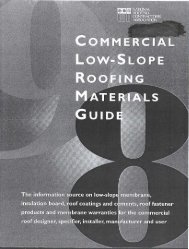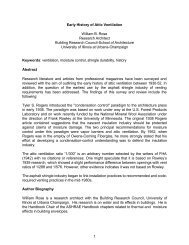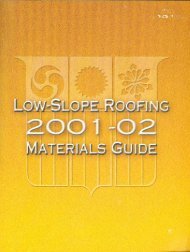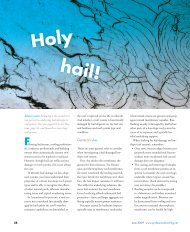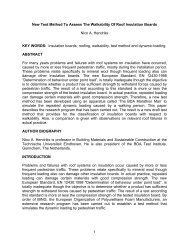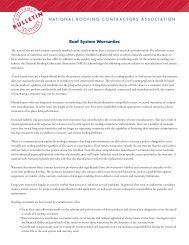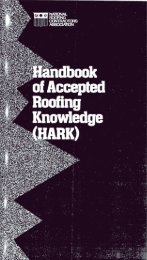1 Aging and Hail Research of PVC Membranes Frank J. Foley, Jim ...
1 Aging and Hail Research of PVC Membranes Frank J. Foley, Jim ...
1 Aging and Hail Research of PVC Membranes Frank J. Foley, Jim ...
Create successful ePaper yourself
Turn your PDF publications into a flip-book with our unique Google optimized e-Paper software.
Underlying logic would support that the content <strong>and</strong> quality <strong>of</strong> plasticizerbelow the reinforcement serves as a reservoir <strong>of</strong> replacement forplasticizer, which degrades <strong>and</strong> departs the membrane from the topsurface (a sort <strong>of</strong> “balanced equilibrium”). Within this logic, however, theweave structure <strong>of</strong> the fabric reinforcement <strong>and</strong> the presence <strong>of</strong> a coatingaround the reinforcement potentially promote or limit the amount <strong>of</strong>migration from bottom film to top film. Regardless <strong>of</strong> logic, if the layerabove the fabric surfacing loses significant plasticizer, then the top surfacebecomes embrittled <strong>and</strong> loses impact resistance.2. The hidden flap undergoes some small degree <strong>of</strong> aging.Unlike the weathered portion <strong>of</strong> a cross-seam sample, the portion <strong>of</strong>membrane hidden under the flap looks new <strong>and</strong> feels supple. However,because the hidden flap is exposed to ambient temperature <strong>and</strong> humidity,the content <strong>of</strong> the plasticizer measured in the hidden flap is not exactly thesame content <strong>of</strong> plasticizer existing in the membrane when the productwas first shipped. This analysis does not incorporate an estimate <strong>of</strong> thissmall rate <strong>of</strong> hidden flap aging.Micrometer Measurement <strong>of</strong> Membrane ThicknessAs conventional <strong>PVC</strong> membranes are exposed <strong>and</strong> aged, a change in thickness occurs.As an additional analysis, micrometer measurements <strong>of</strong> the cross-seam samples weremade for both the hidden flap <strong>and</strong> the exposed portion. Measurements were made infive locations on each side (hidden <strong>and</strong> exposed) <strong>of</strong> each cross-seam sample <strong>and</strong> theaverage <strong>of</strong> the five measurements are reported. Metric data is <strong>of</strong>fered simply as aconversion.<strong>Hail</strong> Simulation Testing <strong>of</strong> Membrane Panels<strong>Jim</strong> D. Koontz & Associates, Inc. used the larger 3-foot by 3-foot (.9 m by .9 m) section<strong>of</strong> each exposed membrane for hail simulation testing. The following conditions weredefined for this simulated hail testing.Simulation <strong>of</strong> <strong>Hail</strong>stone ProjectileSpheres <strong>of</strong> frozen water were used as projectiles for impact testing against the largemembrane samples. The ice sphere test method was selected since laboratory cast icespheres closely correlate with hail. Prior studies have shown that approximately 75-percent <strong>of</strong> large-sized hail is spherical or nearly spherical in shape. 6 <strong>Hail</strong> density rangeshave been reported between 0.02 lb/inch 3 <strong>and</strong> 0.03 lb/inch 3 (0.7 <strong>and</strong> 0.91 gm/cm 3 ) thelatter value being the density <strong>of</strong> pure ice. The ice spheres used in this research werecast pure ice (Photo 2).11




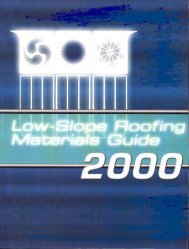
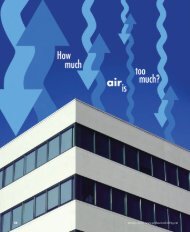
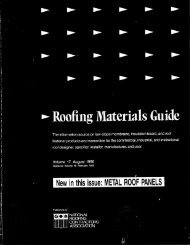
![Wm] - National Roofing Contractors Association](https://img.yumpu.com/36696816/1/190x245/wm-national-roofing-contractors-association.jpg?quality=85)

